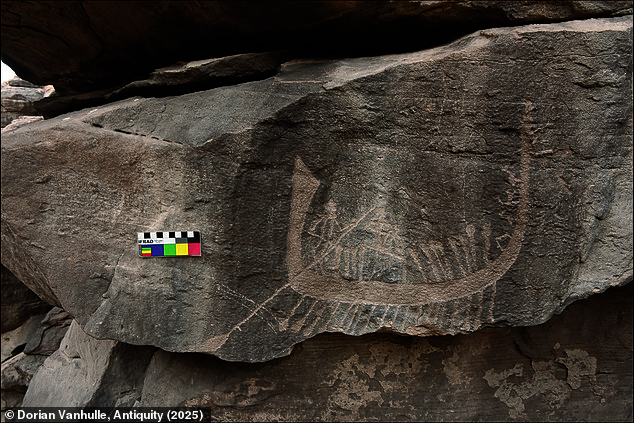Unearthing the Secrets of Ancient Egyptian Power
Archaeologists have made a remarkable discovery in southern Egypt, uncovering a rare rock carving that could shed light on the early days of the Egyptian state. This ancient artwork, found carved into a stone near the city of Aswan, is believed to date back to the fourth millennium BC—centuries before the construction of the first pyramids. The well-preserved carvings depict a figure seated on an ornate boat, pulled by five individuals while another steers with an oar. The seated figure exhibits features commonly associated with the earliest Egyptian kings, such as the long, pointed fake beards worn by pharaohs.
According to a recent study published in the journal Antiquities, this figure is thought to represent a member of the ancient Egyptian political and military elite from the First Dynasty period. This era marked a crucial turning point in Egyptian history, as it saw the beginnings of political unification across the region. This process ultimately led to the formation of the Egyptian state under the first pharaoh, Narmer, around 3100 BC. However, researchers are confident that the figure depicted is not Pharaoh Narmer himself, leaving the true identity of this warrior elite unknown.
The fascinating carving was discovered in a large outcropping of sandstone in an area that has been used as a quarry since at least 330 BC. While multiple carvings from different periods have been found in the vicinity, this latest discovery is the first to date back to the First Dynasty. The image was found covered with rubble along a narrow recess accessible via a sandy ledge. When it was created, anyone standing by the carving would have had a clear view down to the Nile below.
In the depiction, the boat faces north, which would mean it was traveling upstream if it were moving along the Nile. Researchers suggest that this orientation may explain the presence of the five figures pulling the boat using ropes. The significance of the boat motif in ancient Egyptian art cannot be overstated, as it appears frequently in various forms of artistic expression.
Dr. Dorian Vanhulle, an Egyptologist at the Musée du Malgré-Tout in Belgium and the author of the study, explains that the boat is a ubiquitous symbol in ancient Egyptian culture, carrying complex ideological and symbolic meanings. By comparing the carving to other depictions of boats from different periods, Dr. Vanhulle was able to determine the age of the image. His analysis suggests that the figure was carved during the transition into the Early Dynastic period, following the unification of Upper and Lower Egypt.
This period was pivotal in the development of ancient Egyptian culture, as it marked the emergence of the first political structures and the development of writing. However, the exact nature of this transition and the social dynamics of the time remain unclear. In depictions from this era, groups of figures capped with feathers gradually give way to images showing a single figure wearing a crown. This shift indicates a move towards centralized power, with early forms of authority centered around local or regional leaders who often clashed with one another.
Evidence suggests that the transition was likely marked by conflict and violence. Dr. Vanhulle notes that the processes leading to the formation of the Egyptian state are still difficult to fully understand. The newly discovered carving offers valuable insights into how the political elite spread their influence and asserted their power.
Importantly, the carving bears a strong resemblance to the official imagery produced at the beginning of Pharaoh Narmer’s reign. This similarity, combined with the high quality of the engraving, suggests that the work was commissioned by someone of significant status. Dr. Vanhulle emphasizes that the rock panel is an important addition to the existing corpus of engravings, helping to better understand the role of rock art in the events that led to the formation of the Egyptian state.
Rock compositions became a tool for authorities to communicate, mark the landscape, and assert their power. This discovery adds to our understanding of how ancient Egyptians used visual symbols to convey messages of dominance and legitimacy, shaping the course of their civilization.







